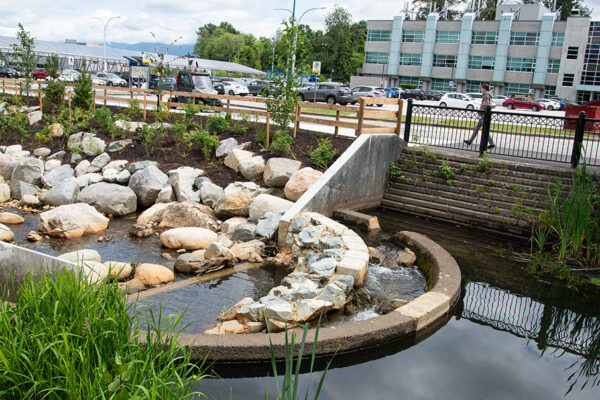
Re-establish full functioning of ecosystem capacity while preserving student and employee safety. Considerations include number and vitality of habitat and plant and animal species.
Provide consideration for species’ preservation and restoration both on and off-campus that are affected by BCIT activities.
Why we are working towards becoming ecologically restored
- Increases the quantity and improves the quality of exterior spaces, improving water balance, natural habitat and biodiversity, carbon sequestration, and human enjoyment.
- Preserves green space and recovers lost streams and directs development away from natural areas.
Ecological restoration management
Ecological restoration at BCIT allows sustainable land use by restoring natural habitat, plants, and animals, both on-campus and wherever on-campus activities affect off-campus ecology.
In addition to restoration efforts, BCIT has committed to protect the current green space on campus as stated in a formal memorandum of understanding signed by BCIT with the City of Burnaby in 2001.
- Daylight Guichon Creek
- Integrated Storm Water Management
- Maintain or increase green spaces on campus
- Plant predominantly native species
- Avoid the use of herbicides and pesticides
- Daylight and restore culverted streams to fish-bearing capacity
A living lab for the future
Our Burnaby campus is being transformed with new buildings and infrastructure to create unparalleled places to learn, innovate and co-create. We will also enliven the campus with new greenways, bike lanes, on-campus housing and public spaces. These will help create stronger connections with our environment and with each other. The urban ecological restoration of Guichon Creek will bring a weaving waterway to life across campus and become an iconic symbol of BCIT’s sustainability commitment.
Guichon Creek restoration
It’s hard to believe that Guichon Creek on the Burnaby Campus was an underground drainage channel 40 years ago. Fish, Wildlife, and Recreation and Ecological Restoration students and staff have worked for 25 years to restore the creek by re-establishing streamside vegetation, enhancing in-stream habitat, and improving water quality, with help from donors and the City of Burnaby. Now a successful example of urban stream restoration, and needed habitat for fish and wildlife, the creek was even repopulated with cutthroat trout in 2006.
The Burnaby Campus Master Plan (2007) included plans to “daylight” the rest of the creek from its underground culvert from SE16 at Ford Street, all the way to Canada Way. Restoring a stream from underground pipes to the surface is called”daylighting”, and this process reduces toxic run-off into lakes, increases trout and salmon populations, protects riparian biodiversity, and reminds us of the fragile beauty of our environment, and the many reasons to protect it. Guichon Creek is only one example of the Fish, Wildlife, and Recreation program’s conservation and restoration projects.




